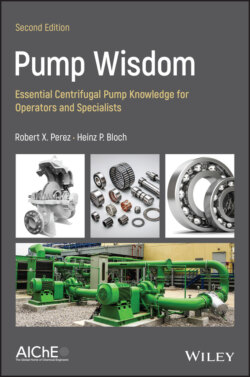Читать книгу Pump Wisdom - Robert X. Perez - Страница 25
Why Not to Install Pump Sets in the As‐Shipped Condition
ОглавлениеThere are obviously some flaws in the grout surrounding the baseplate in Figure 3.3. (On the other hand, the equipment owner invested in a very modern small oil mist lubrication unit). Note the hollow space under the electric motor. Lack of support under motors often invites resonant vibration. Rigorous written installation procedures are needed and must be adhered to if long equipment life is to be achieved.
Before delving into other installation matters, note the alignment jacking provisions in Figure 3.4, where the purchaser specified an arrangement that allows insertion (and later removal) of alignment‐jacking tabs in the x‐ and y‐directions next to each of the four motor feet. (A fixed jacking tab arrangement can be seen later – Figure 14.3).
Portable jacking tabs, Figure 3.4, (inserted in a welded‐on bracket), allow driver alignment moves to be made. Thereafter, the jacking bolts are backed‐off, and the entire tab is removed. When jack screws are left tightened against the motor feet, motor heat, and thermal growth might force the feet into these bolts even more, sometimes causing the entire motor casing to distort [1]. Note, therefore, that backing‐off jacking bolts should be one of many installation checklist items.
Figure 3.3 A typical, but obviously flawed, “conventional” pump foundation.
Source: Lubrication Systems Company, Houston, Texas.
Figure 3.4 Removable alignment jacking tabs shown inserted in three of four locations next to the two motor feet shown here.
Source: Stay‐Tru®, Houston, Texas.
To ensure level‐mounting throughout, the baseplate is placed on a foundation into which hold‐down bolts or anchor bolts (Figure 3.5) were encased when the reinforced concrete foundation was being poured [2]. For proper stretch and long life, these anchor bolts (Figure 3.5) must have a diameter‐to‐length ratio somewhere between 1 : 10 and 1 : 12. The anchor bolts are provided with steel sleeves and soft filler. The sleeves prevent entry of grout and accommodate the differing amounts of thermal growth of a concrete foundation relative to that of a steel baseplate.
Figure 3.5 Foundation anchor bolts and sleeves encased in pump foundation.
Source: Based on Barringer and Monroe [2].
